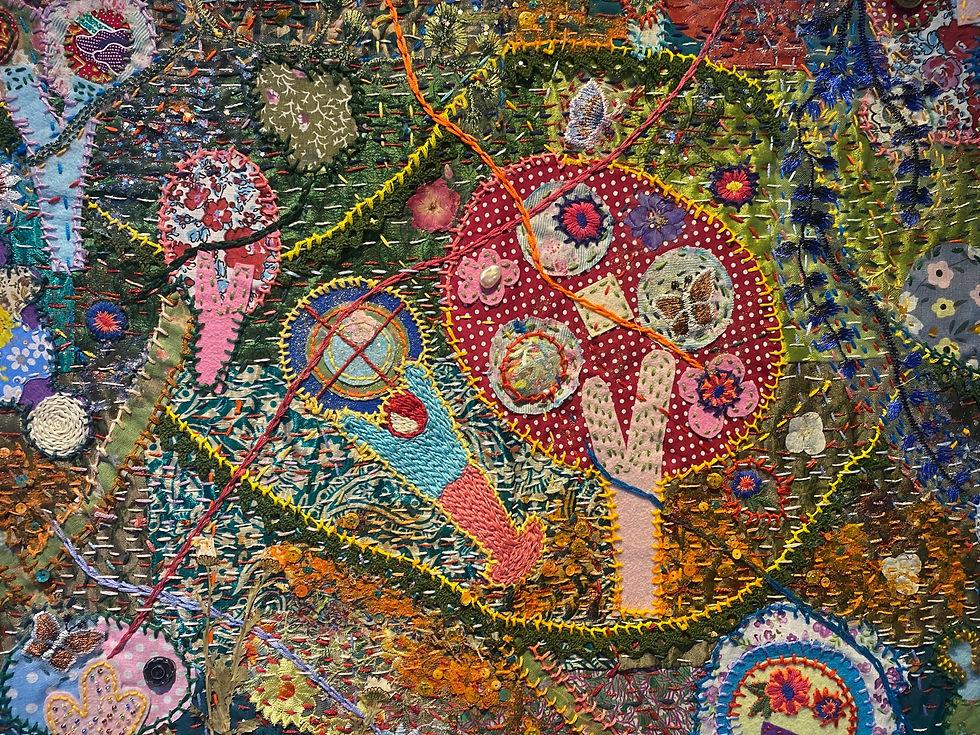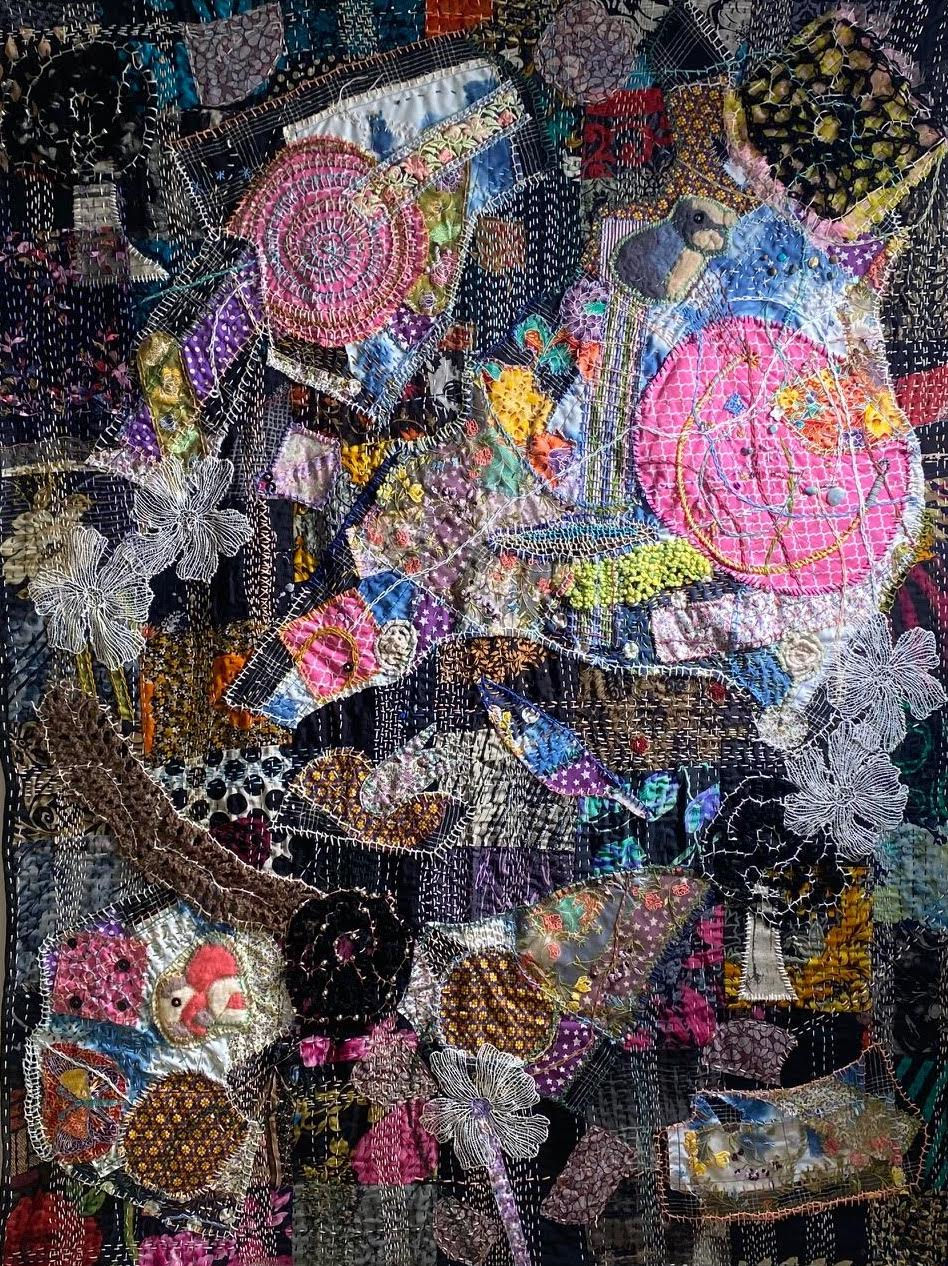Kamonchanok Phon-ngam: “Threads of Inner Harmony”
- Eye Level
- Jul 29
- 5 min read
Updated: Aug 5
IMUR keeps up the hot streak with a winning textile show from an optimist with a needle.

A fact that children know but grownups often forget: if you’ve got a pair of buttons and a length of string, you have all it takes to make a face. A sweet face, too, friendly and approachable, since string is soft and pliable, and everybody likes to fasten and unfasten buttons. Stitched smiles and shiny plastic peepers win us over quick, and even dolls assembled for mean scraps of fabric and loose twine speak straight to our deepest pleasures and protective impulses. Textiles, it turns out, are tethered to the heart. They remind us of our first tactile experiences, and the small, sheltered, hopeful world we inhabit before we’ve even got words to attach to what we’re seeing.
Kamonchanok Phon-ngam has buttons and beads in surplus, plus string and yarn of different colors and thicknesses. She’s got strips of fabric in pajama patterns, circles of tufted felt, and enough glitter and glue to keep a table of summer campers occupied for hours. The fiber artist also has something that you can’t buy on Etsy or unearth from a thrift shop: a wondrously clear emotional memory of how it feels to be very, very young.
The anxiety of early childhood is present in “Threads of Inner Harmony,” a delightful solo show at IMUR (67 Greene St.) curated by the tireless Ivy Huang, but there is not very much of it. Instead, the Thai textile artist’s pieces hum with security, and maybe even serenity. They remind us of how the big world unfolds before a blooming consciousness.
“Threads of Inner Harmony” is relentlessly fresh and remarkably uncynical. Phon-ngam’s work, scored by stitch-trails that streak across elaborate designs with a topographic quality, is pregnant with possibilities. The artist invites your eyes to wander freely around surfaces that she’s packed with visual happenstance, encountering a button here, a bead there, a peculiar pattern in the far corner, a small nest of colored thread inside a gauzy pouch, and tiny representations of birds, bees, and plants. Her tapestry-like wall hangings can feel like dashed-line adventure maps; trips through a non-threatening Candyland of her own invention.

Like a good schoolteacher, she’ll sometimes tell you right where to stand in order to get her message. “Rebirth,” a stunner that awaits travelers at the far end of the gallery’s second floor room, models the behavior (and the childlike wonder) she’s expecting from her viewer. She’s sewn an image of a butter-headed child, back turned to us, into the fabric at the very bottom of her piece. Above his head is a portal ringed with loose, lace-like stitching, a rough rectangle of red, polka-dotted cloth, and a charm, attached like an overcoat button to the rest of the artwork, in the shape of an open eye. Here is Phon-ngam’s message to us: be alert, step through the door, and, with wide-open hearts, allow the universe to reveal itself to you.
When it does, it presents itself with a rush of abundance. The winding roads of thread direct us to flowers and trees, suns and smiling faces, saguaro cacti, butterflies, lakes and fish, a shape that may be the front of an automobile, and people, lots of people, standing, reaching, and sometimes soaring. None of this is immediately apparent — at first, it appears to be a dazzling design, a play of textile shapes and patterns, and the crossrhythms of stitches in different thicknesses and colors. But the more the eye acclimates to Phon-ngam’s symbolic language, the more detail comes into focus. “Rebirth,” for instance, contains a horizon line, with multiple sheltering arcs around the St. Exupéry-like main character who stands as a proxy for us, and then a skyful of immanence, constellations of objects, stitching like solar waves, and radiating optimism. Here is an artwork you’d be happy to tuck a child into. Her future, it sings to us, will be chaotic, beautiful, dazzling and bright.

Because Phon-ngam harmonizes fabrics, patterns, and colors in a manner that I am tempted to call seamless (sorry), her figurative elements are never too obvious. Instead, her characters are always awash in the mystical, surrounded by possibility, woven into the wider world and ready to receive the cheerful promise of the heavens. In “Every Drop, A New Beginning,” the artist plops down her winsome little protagonist right in the middle of blue circle and lets the scene whirl around her, implying circular motion with every looping diagonal stitch. She could be on her back in a swimming pool, dreaming of the days to come. Above her, puffy grey clouds open up and shower her with white, black, and pink stitch-droplets of rain. It’s a summer storm — benign as they come, and baptismal in its effect.

So generous is “Threads of Inner Harmony” that it’s possible to miss Phong-ngam’s virtuosity. The artist juggles different textiles, different widths of string and cord, shapes knotty and troublesome cut from old cloth, and never drops a stitch (double sorry). Though she’s not averse to letting her fray and shag show for storytelling reasons, the pure intensity of her sewing — she digs her needle into almost every square inch of her pieces — betrays the meticulousness of her approach and, perhaps, a deep compulsion to hold things together.
“Through the Darkness,” a gorgeous piece big enough to be a bedspread, is a playground for her pin, with bashful flower pedals rendered in thin white lines, webs of black yarn, and one arc of orange rope that feels thick enough to skip. She’s festooned the middle of the piece with bead store plastic gems and gold charms, and toward the upper right corner, she’s provided us a friend: a grey felt bunny. Across the gallery hangs “Data Invisible,” a play of lace, cloth flowers, imitation mother of pearl, and the silhouette of a fern, affixed to the cream-colored sheets like an iron-on patch. Like everything in “Inner Harmony,” it’s loaded with visual happenstance. It keeps giving and giving, perpetually setting the table, offering new revelations with each glance.

Kamonchanok Phon-ngam is headquartered on the other side of the river. But if you’re a New Jersey gallerygoer, her work is likely to remind you of others who’ve been widely shown in the Garden State during this long overdue moment for textile art. Like Ann Vollum, she shows a facility for handling unusual fabrics; like Lisa Lackey, her pieces are large, and immersive, and rich in narrative detail. She also fits in well with a pair of imps with long memories of childhood who’ve recently cut loose at IMUR: Jodi Gerbi, painter of toys and abandoned fairground prizes, and Susan Eldridge Ward, whose colorful canvases are populated by cheerful little beasts who defy gravity and expectation and hide out in plain view on a fantasy landscape.
Yet Phon-ngam absolutely has her own bag, and her own protective magic spells to weave. In “Threads,” she lets off fireworks in fabric but never once makes you think you might burn your fingers. It’s a world safe enough for a toddler — or a shell-shocked grownup back on her heels after the turbulence of the past few years. She’s given us all something to wrap ourselves in.
(The IMUR Gallery is open Thursdays and Fridays from 3 p.m. until 7 p.m. and 2 p.m. until 6 p.m. on Saturdays. “Threads of Inner Harmony” closes on Aug. 9.)




